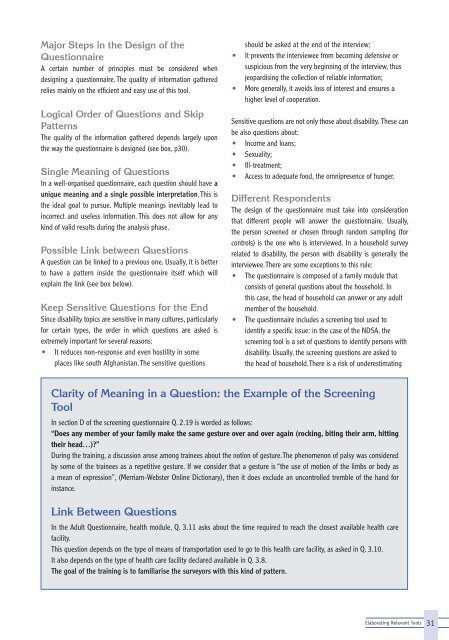Conducting Surveys on Disability: A Comprehensive Toolkit
Conducting Surveys on Disability: A Comprehensive Toolkit
Conducting Surveys on Disability: A Comprehensive Toolkit
You also want an ePaper? Increase the reach of your titles
YUMPU automatically turns print PDFs into web optimized ePapers that Google loves.
Major Steps in the Design of the<br />
Questi<strong>on</strong>naire<br />
A certain number of principles must be c<strong>on</strong>sidered when<br />
designing a questi<strong>on</strong>naire. The quality of informati<strong>on</strong> gathered<br />
relies mainly <strong>on</strong> the efficient and easy use of this tool.<br />
Logical Order of Questi<strong>on</strong>s and Skip<br />
Patterns<br />
The quality of the informati<strong>on</strong> gathered depends largely up<strong>on</strong><br />
the way the questi<strong>on</strong>naire is designed (see box, p30).<br />
Single Meaning of Questi<strong>on</strong>s<br />
In a well-organised questi<strong>on</strong>naire, each questi<strong>on</strong> should have a<br />
unique meaning and a single possible interpretati<strong>on</strong>. This is<br />
the ideal goal to pursue. Multiple meanings inevitably lead to<br />
incorrect and useless informati<strong>on</strong>. This does not allow for any<br />
kind of valid results during the analysis phase.<br />
Possible Link between Questi<strong>on</strong>s<br />
A questi<strong>on</strong> can be linked to a previous <strong>on</strong>e. Usually, it is better<br />
to have a pattern inside the questi<strong>on</strong>naire itself which will<br />
explain the link (see box below).<br />
Keep Sensitive Questi<strong>on</strong>s for the End<br />
Since disability topics are sensitive in many cultures, particularly<br />
for certain types, the order in which questi<strong>on</strong>s are asked is<br />
extremely important for several reas<strong>on</strong>s:<br />
• It reduces n<strong>on</strong>-resp<strong>on</strong>se and even hostility in some<br />
places like south Afghanistan. The sensitive questi<strong>on</strong>s<br />
should be asked at the end of the interview;<br />
• It prevents the interviewee from becoming defensive or<br />
suspicious from the very beginning of the interview, thus<br />
jeopardising the collecti<strong>on</strong> of reliable informati<strong>on</strong>;<br />
• More generally, it avoids loss of interest and ensures a<br />
higher level of cooperati<strong>on</strong>.<br />
Sensitive questi<strong>on</strong>s are not <strong>on</strong>ly those about disability. These can<br />
be also questi<strong>on</strong>s about:<br />
• Income and loans;<br />
• Sexuality;<br />
• Ill-treatment;<br />
• Access to adequate food, the omnipresence of hunger.<br />
Different Resp<strong>on</strong>dents<br />
The design of the questi<strong>on</strong>naire must take into c<strong>on</strong>siderati<strong>on</strong><br />
that different people will answer the questi<strong>on</strong>naire. Usually,<br />
the pers<strong>on</strong> screened or chosen through random sampling (for<br />
c<strong>on</strong>trols) is the <strong>on</strong>e who is interviewed. In a household survey<br />
related to disability, the pers<strong>on</strong> with disability is generally the<br />
interviewee. There are some excepti<strong>on</strong>s to this rule:<br />
• The questi<strong>on</strong>naire is composed of a family module that<br />
c<strong>on</strong>sists of general questi<strong>on</strong>s about the household. In<br />
this case, the head of household can answer or any adult<br />
member of the household.<br />
• The questi<strong>on</strong>naire includes a screening tool used to<br />
identify a specific issue: in the case of the NDSA, the<br />
screening tool is a set of questi<strong>on</strong>s to identify pers<strong>on</strong>s with<br />
disability. Usually, the screening questi<strong>on</strong>s are asked to<br />
the head of household. There is a risk of underestimating<br />
Clarity of Meaning in a Questi<strong>on</strong>: the Example of the Screening<br />
Tool<br />
In secti<strong>on</strong> D of the screening questi<strong>on</strong>naire Q. 2.19 is worded as follows:<br />
“Does any member of your family make the same gesture over and over again (rocking, biting their arm, hitting<br />
their head…)”<br />
During the training, a discussi<strong>on</strong> arose am<strong>on</strong>g trainees about the noti<strong>on</strong> of gesture. The phenomen<strong>on</strong> of palsy was c<strong>on</strong>sidered<br />
by some of the trainees as a repetitive gesture. If we c<strong>on</strong>sider that a gesture is “the use of moti<strong>on</strong> of the limbs or body as<br />
a mean of expressi<strong>on</strong>”, (Merriam-Webster Online Dicti<strong>on</strong>ary), then it does exclude an unc<strong>on</strong>trolled tremble of the hand for<br />
instance.<br />
Link Between Questi<strong>on</strong>s<br />
In the Adult Questi<strong>on</strong>naire, health module, Q. 3.11 asks about the time required to reach the closest available health care<br />
facility.<br />
This questi<strong>on</strong> depends <strong>on</strong> the type of means of transportati<strong>on</strong> used to go to this health care facility, as asked in Q. 3.10.<br />
It also depends <strong>on</strong> the type of health care facility declared available in Q. 3.8.<br />
The goal of the training is to familiarise the surveyors with this kind of pattern.<br />
Elaborating Relevant Tools<br />
31

















